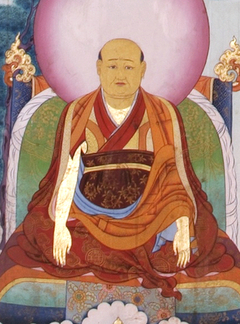Treasury of Precious Qualities Synopsis
A Garland of Fresh Utpala Flowers
A Brief Synopsis of The Treasury of Precious Qualities, a Treatise of Pith Instructions
by Patrul Rinpoche
In general, when giving any Dharma teaching, there is an explanation of 1) the preliminary topics and 2) the actual teaching.
1. The Preliminary Topics
The first has three sections: 1) the ways in which the teachings are given, 2) how the teacher should teach and the students listen, and 3) the benefits of teaching and listening.
1. The Ways in Which the Teachings Are Given
There are three styles of teaching: 1) the style of the buddhas, 2) the style of the śrāvaka arhats, and 3) the style of learned paṇḍitas. The buddhas teach by way of miracles, the śrāvakas by way of the three pure factors, and the paṇḍitas according to how it was done either at Nālandā or Vikramaśīla. At the monastery of Nālandā, the Words of the Buddha were taught in terms of the five perfections and the treatises by means of five principal considerations. The paṇḍitas of Vikramaśīla taught by transforming the audience into suitable vessels and determining the presentations of the teaching. Transforming students into suitable recipients has three points[1] and determining the presentations of the teachings also consists of three points.[2]
2. How to Teach and Listen
This concerns 1) the master who teaches, 2) the students who listen, and 3) what they have in common.
3. The Benefits of Teaching and Listening[3]
This is explained in the text itself.
2. The Actual Teaching
This has two parts: 1) an explanation of the specific topic, and 2) an elaborate explanation of the meaning of the text.
1. Explanation of the Specific Topic
This employs both the five major structural themes and the fourfold interrelated purpose.
2. Elaborate Explanation of the Meaning of the Text
This consists of explanations of the introduction, main part and conclusion. The first, the introduction, includes an explanation of the title, offering prostrations, paying homage and the commitment to compose.
The main part of the text has thirteen chapters.
The conclusion has four parts:[4] 1) the reason for composing the treatise, 2) openly admitting and confessing mistakes and 3) generating delight among followers, and 4) dedicating the roots of virtue. With this the text is completed.
May all be virtuous!
This was written by the Lord of Dharma Patrul Rinpoche when he taught Kunzang Tekchok Dorje.[5]
| Translated by Han Kop with the kind assistance of Khenpo Sonam Tsewang, 2021.
Bibliography
Tibetan Edition
orgyan 'jigs med chos kyi dbang po. "man ngag gi bstan bcos yon tan mdzod kyi bsdus don/ sa bcad ut+pal gsar pa'i phreng ba/." In gsung 'bum/ o rgyan 'jigs med chos kyi dbang po. W1PD107142. 2: 443–444. khreng tu'u: si khron dpe skrun tshogs pa/ si khron mi rigs dpe skrun khang, 2009.
Secondary Sources
dri med 'od zer . "ngal gso skor gsum gyi spyi don." In gsung 'bum/_dri med 'od zer/ ?dpal brtsegs/ mes po'i shul bzhag. W1KG4884. 22: 296–383. pe cin/: krung go'i bod rig pa dpe skrun khang /, 2009.
Jigme Lingpa & Kangyur Rinpoche. 2013. Treasury of Precious Qualities: Book Two: Vajrayana and the Great Perfection. Translated by Padmakara Translation Group. Boulder, CO: Shambhala.
Kangyur Rinpoche. 2001. Treasury of Precious Qualities. Translated by Padmakara Translation Group. Boston and London: Shambhala.
Version: 1.0-20210920
-
These three are: 1) the greatness of the authorial master (mdzad pa po slob dpon gyi che ba), 2) the greatness of the Dharma taught by that author (des mdzad pa chos kyi che ba), and 3) the manner of explaining and listening to the Dharma that possesses such greatness (che ba de lta bu dang ldan pa'i chos de bshad cing mnyan pa'i tshul). See ngal gso skor gsum gyi spyi don legs bshad rgya mtsho, p. 336. ↩
-
1) how the Teacher taught the three turnings of the Wheel [of the Dharma]; 2) how arhats compiled the Teachings; and 3) how scholars composed their treatises. See ngal gso skor gsum gyi spyi don legs bshad rgya mtsho, p. 337. ↩
-
All editions of the text have "gsum pa bshad cing nyan pa’i tshul bstan pa". However, this does not accord with the outline presented in the text itself, which has "bshad cing nyan pa'i phan yon bstan pa". Nor does it correspond with Longchenpa's An Ocean of Eloquence: An Overview of the Trilogy of Comfort and Ease (ngal gso skor gsum gyi spyi don legs bshad rgya mtsho), the most likely source of this outline. ↩
-
The Tibetan here says "three" but the text then goes on to list four points. ↩
-
Almost certainly Gyarong Namtrul Kunzang Tekchok Dorje P8005 ↩
